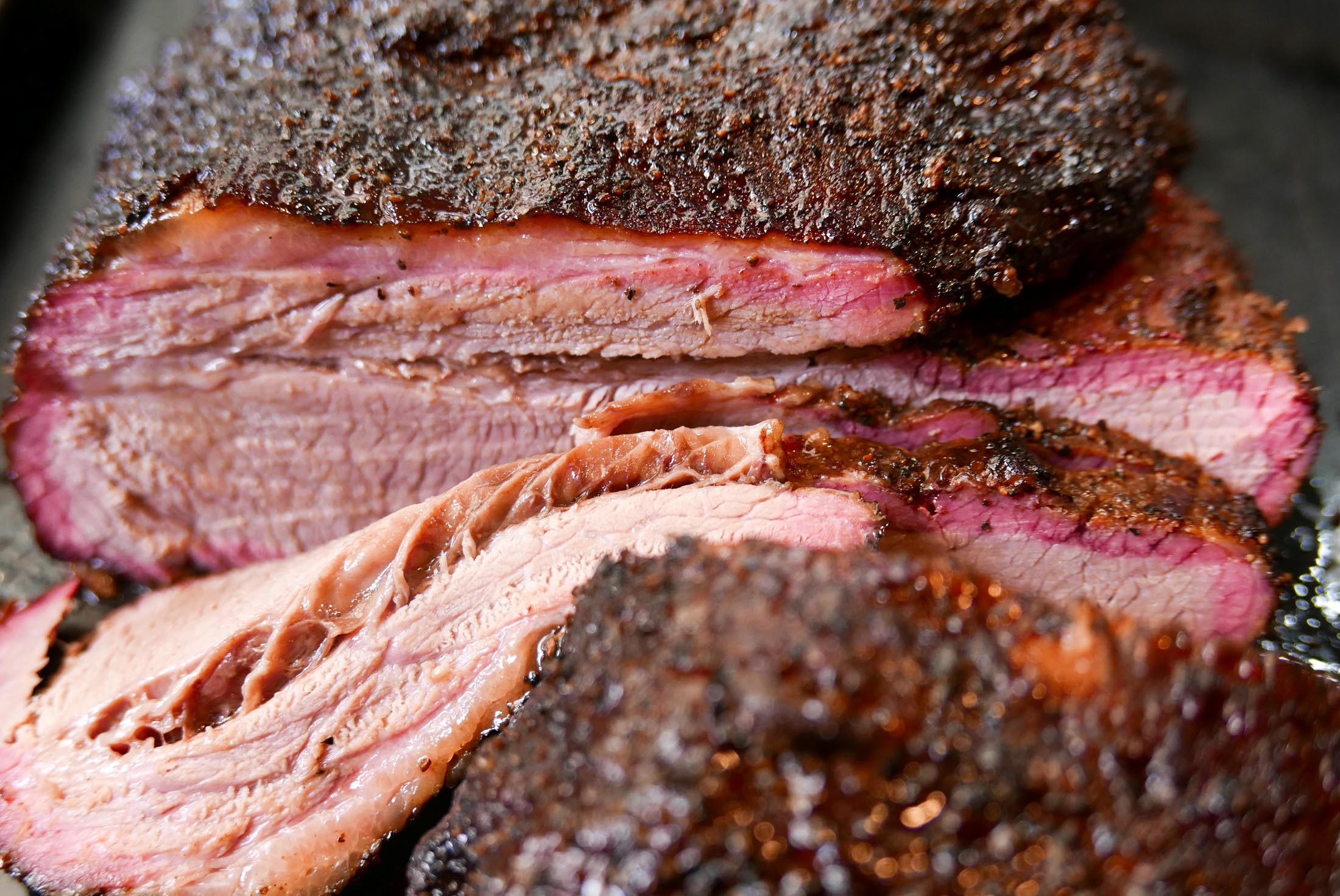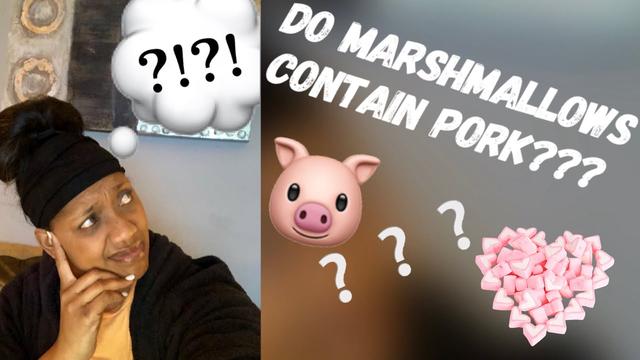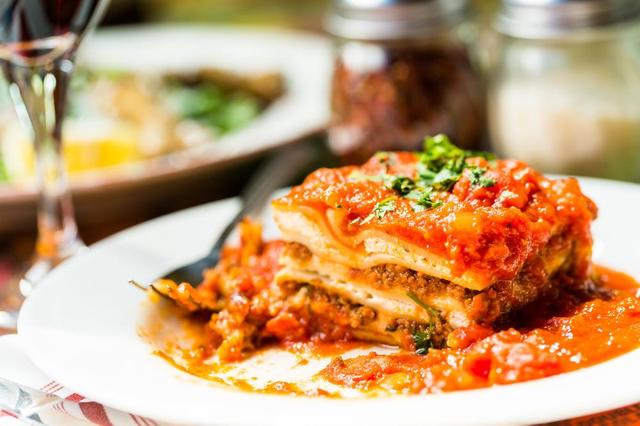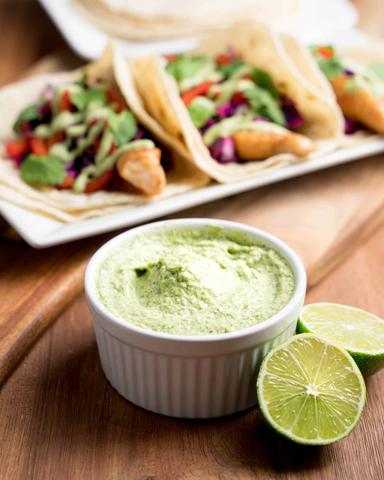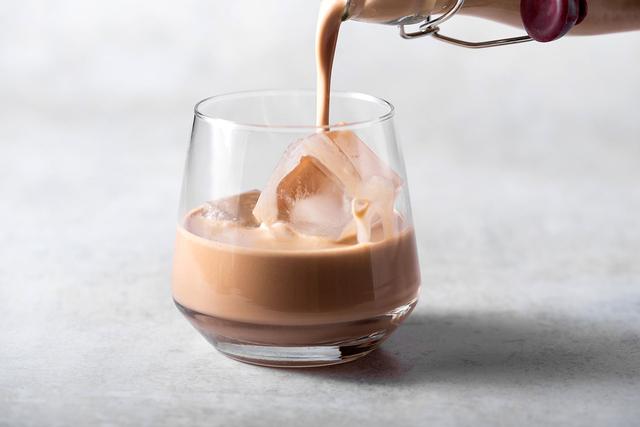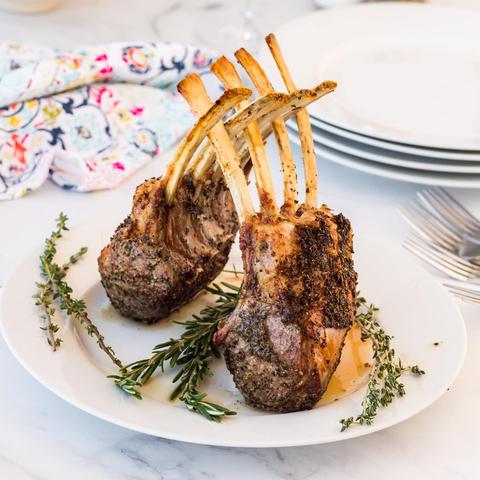
Discover the epitome of gourmet indulgence with our tantalizing rack of lamb recipe. Elevate your culinary skills and create a mouthwatering masterpiece that will leave your taste buds in awe. With simple yet elegant ingredients, this dish promises to be a showstopper at any dinner table. Unleash your inner chef and let the succulent flavors of perfectly cooked lamb take center stage.
Roasted Rack of Lamb
This Roasted Rack of Lamb is much easier to make than you might think and it’s an impressive and amazing main dish. When I first made this recipe, I was looking for something impressive to serve to guests at a dinner party, but after that first time, I started making it regularly, even for weeknight dinners, because it’s so addictive! If you haven’t tried making a rack of lamb before, you should definitely give this recipe a try. You’ll see how easy it is to make, and once you taste the amazing dry rub you’ll never go back.
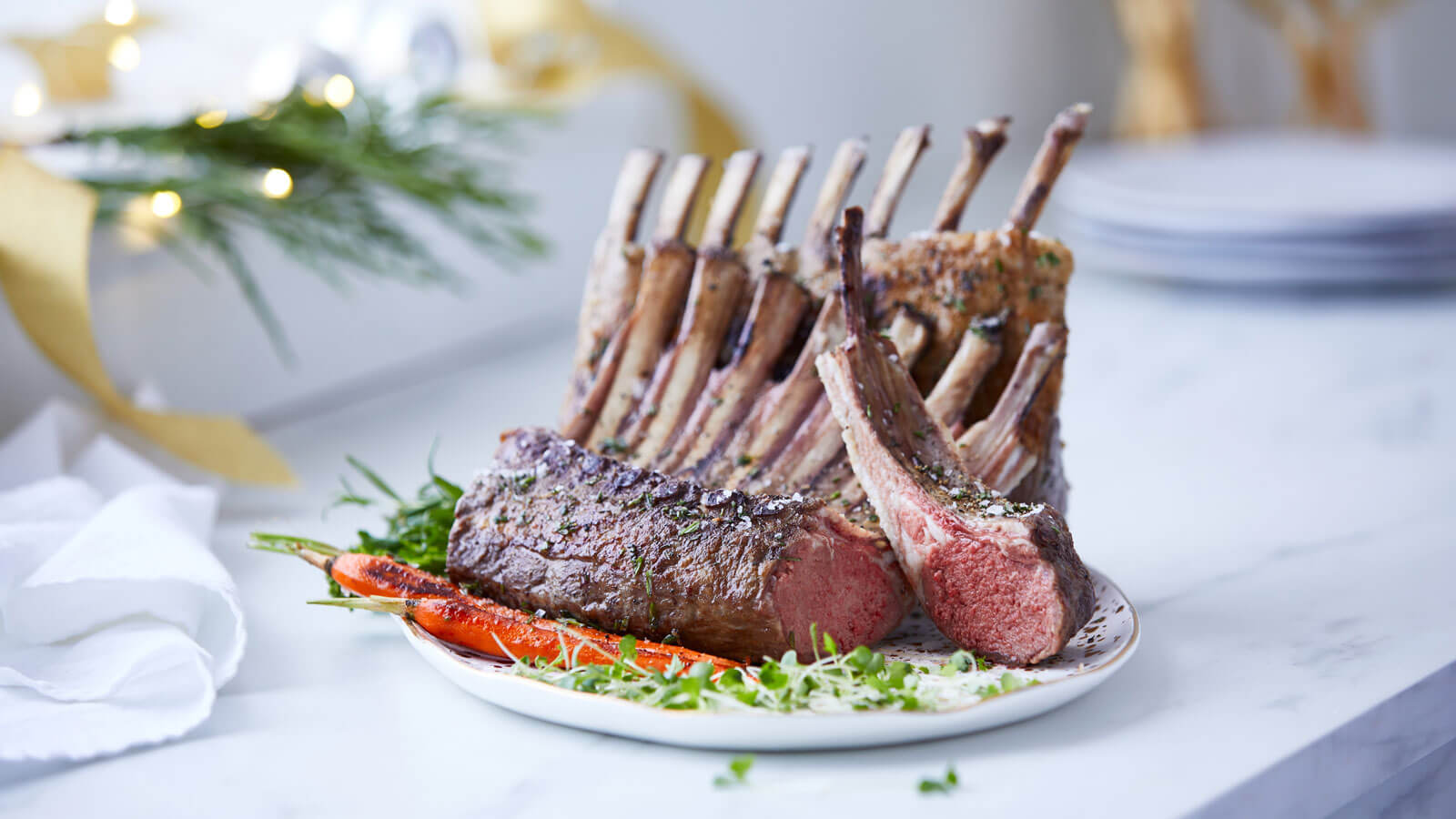
The only difficulty with rack of lamb is finding and buying the right thing. In most cases, you’ll be able to purchase a French cut or trimmed rack of lamb at the grocery with no problem. However, sometimes it isn’t trimmed yet. Rack of lamb is often French trimmed (also known as Frenching in the US), This is when the rib bones are exposed by cutting off the fat and meat that covers them. It gives each rib a sort of built-in handle and makes each rib look a bit like a lollipop when you pick it up. It’s not necessary to french trim the rack of lamb, but it does make it fancier, and somewhat easier to eat.
I’ve seen so many recipes for Rack of Lamb that require a long marinating of the lamb – often overnight. That’s just not necessary. In fact, I caution against it for this preparation. The lamb meat itself is so wonderfully tender and delicious that there’s no reason to marinate it. So skip that step.
The one thing you do need to do to prepare the lamb is to take the thick fat cap off the meat if it was left on by the butcher. You’ll know it right away if it has fat covering the top of the meat. Cut most of that fat off the meat. At first, I didn’t want to do that. I wanted to try to render that fat and keep it on the meat for flavor/juiciness, but I quickly learned that wasn’t really viable. It takes quite a bit of time to properly render that much fat, and you may end up overcooking the lamb if you try. So now, I recommend cutting most of it off. Some fat remaining will add that flavor.
I highly recommend the dry rub in this recipe. It adds a tremendous amount of flavor because it forms a good crust on the lamb as it cooks. Skipping the rub would be a huge shame. However, don’t add the rub before searing the meat. The rub tends to burn when searing, and you don’t want that. To prevent this, just sprinkle on some salt and pepper before searing, then let the rack cool slightly and add the rub right before putting it in the oven.
It’s important to bring the lamb to room temperature before cooking. This will ensure the center reaches the right temperature without overcooking the outside. Don’t skip this step.
Trim any fat from the top of the lamb rack. Sprinkle with salt and pepper.
Preheat the oven to 450 degrees F. You’ll need a baking sheet or roasting pan. Line it with foil and a wire rack. The lamb will sit on top of the rack while cooking.
Sear the lamb in a hot pan on both sides. It takes just a few minutes per side to sear. You don’t have to sear the ends.
Searing first locks in flavor and starts forming a good crust.
Remove it from the pan and allow it to cool slightly.
When the lamb has cooled enough to touch it, coat the whole rack generously with the rub. I usually have just a small bit of rub leftover.
Place the lamb on the wire rack, meat facing up. Insert a remove oven thermometer into the thickest part of the meat, not touching bone. The meat thermometer is important to ensure you hit the right temperature without overcooking. I prefer medium rare for rack of lamb. I think that’s when the meat is at its best. For medium rare, set the meat thermometer to between 125 and 130 degrees F. If you prefer it medium, set it to 130 or 135.
Roast the lamb until the meat thermometer alarm goes off, about 15 to 25 minutes, depending on your desired doneness. If you don’t have an oven thermometer, check the meat temperature after 10 minutes and every 5 minutes after that to avoid overcooking.
Resting the meat after removing it from the oven is a very important part of the process. When meat cooks, the proteins and fibers seize up and release moisture. The resting time allows those fibers to relax, reabsorbing the moisture they expelled during the cooking process. If you cut into your lamb straight away, those juices would spill out onto the cutting board instead.
The meat will also continue to cook during this resting time, which will bring the internal temperature up to spot on. So remove from the oven and let rest for 10 minutes before cutting.
Cut each rib apart with a large very sharp knife to serve. A serving size is typically between 2 and 4 ribs, depending on your appetite.
What is French Trimmed Lamb?
French trimming is a technique commonly used for lamb racks, also known as Frenching in the US. It involves removing the fat and meat that covers the rib bones, exposing them and giving each rib a built-in handle. This not only makes the rack of lamb look more visually appealing but also makes it easier to eat. French trimming is not necessary for cooking rack of lamb, but it does add a touch of elegance to the dish.
To french trim a rack of lamb, you can either ask your butcher to do it for you or do it yourself at home. If your rack of lamb is not already trimmed, simply use a sharp knife to cut off the fat and meat that covers the rib bones. This will leave each rib exposed and give them a lollipop-like appearance.
French trimmed rack of lamb can be easily found at most grocery stores. However, if you’re unable to find one that is already trimmed, don’t worry! Trimming the rack yourself is a simple process that will take just a few minutes.
Preparing the Lamb

Before cooking, bring the lamb to room temperature. Trim any excess fat from the top of the lamb rack and sprinkle it with salt and pepper.
Preheat the oven to 450 degrees F. Sear the lamb in a hot pan on both sides for a few minutes per side to lock in flavor and form a crust. Remove from the pan and allow it to cool slightly.
Once cooled, coat the entire rack of lamb with a dry rub. Place the lamb on a wire rack, meat facing up, and insert an oven thermometer into the thickest part of the meat.
Roast the lamb in the preheated oven until it reaches your desired level of doneness. For medium rare, aim for an internal temperature between 125 and 130 degrees F. This typically takes about 15 to 25 minutes, depending on your preference.
After removing from the oven, let the lamb rest for 10 minutes before cutting. This allows the fibers to relax and reabsorb moisture, resulting in juicier meat.
To serve, cut each rib apart using a large sharp knife. A typical serving size is between 2 and 4 ribs per person.
Note: The provided paragraphs have been condensed for brevity while retaining key information.
Dry Rub for Lamb
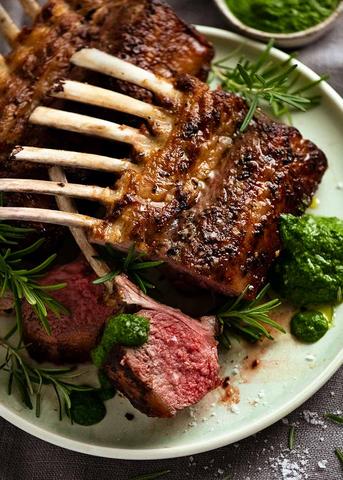
When preparing a rack of lamb, it’s important to use a flavorful dry rub to enhance the taste of the meat. This recipe calls for a delicious and aromatic blend of herbs and spices that will create a mouthwatering crust on the lamb as it cooks. The combination of salt, pepper, garlic powder, dried thyme, dried rosemary, and paprika adds depth and complexity to the dish.
To make the dry rub, simply mix together all the ingredients in a small bowl. Ensure that each rib is generously coated with the rub before placing it in the oven. The rub not only adds flavor but also helps to form a crispy crust on the lamb as it roasts.
How to Roast Rack of Lamb
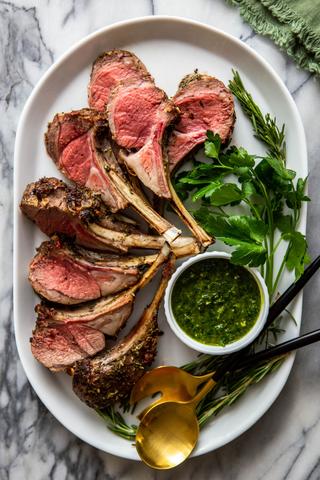
Making a roasted rack of lamb is easier than you might think. Start by bringing the lamb to room temperature before cooking and trimming any fat from the top of the rack. Sprinkle with salt and pepper.
Preheat your oven to 450 degrees F and line a baking sheet or roasting pan with foil and a wire rack. Sear the lamb in a hot pan on both sides, then remove from the pan and let it cool slightly.
Coat the whole rack generously with a dry rub right before putting it in the oven. Insert an oven thermometer into the thickest part of the meat, not touching bone. For medium rare, roast the lamb until the thermometer alarm goes off, about 15 minutes.
After removing from the oven, let the lamb rest for 10 minutes before cutting. This resting time allows the fibers to relax and reabsorb moisture, resulting in tender and juicy meat. Cut each rib apart with a large sharp knife to serve.
Sear the Lamb
To begin preparing the roasted rack of lamb, start by bringing the lamb to room temperature. Trim any excess fat from the top of the lamb rack and sprinkle it with salt and pepper. This will enhance the flavors of the meat while it cooks.
Next, sear the lamb in a hot pan on both sides. This process only takes a few minutes per side and helps to lock in flavor and form a delicious crust on the outside of the meat. There is no need to sear the ends of the rack.
Once you have seared the lamb, remove it from the pan and allow it to cool slightly. When it is cool enough to handle, generously coat the entire rack with a dry rub mixture. The dry rub adds an incredible amount of flavor and creates a savory crust as it cooks.
It’s important not to add the dry rub before searing, as it tends to burn during this process. Instead, sprinkle some salt and pepper before searing and then apply the dry rub right before placing it in the oven.
Preheat your oven to 450 degrees F (230 degrees C) and prepare a baking sheet or roasting pan by lining it with foil and placing a wire rack on top. Place the seasoned lamb rack on top of the wire rack, with the meat facing up.
Insert an oven thermometer into the thickest part of the meat, making sure that it does not touch bone. This will help you monitor its internal temperature accurately without overcooking.
Roast the lamb in the preheated oven until your meat thermometer alarm goes off or for about 15 to 25 minutes, depending on your preferred level of doneness. If you do not have an oven thermometer, check the meat temperature after 10 minutes and every 5 minutes thereafter to avoid overcooking.
After removing the lamb from the oven, let it rest for at least 10 minutes before cutting into it. This resting period allows the meat fibers to relax and reabsorb the juices that were released during cooking. It also allows the internal temperature of the meat to reach its peak, resulting in perfectly cooked lamb.
By following these steps, you can easily make a delicious and impressive roasted rack of lamb that will wow your guests or elevate any weeknight dinner.
Add the Rub
Coat the whole rack of lamb generously with the dry rub. The rub adds a tremendous amount of flavor and forms a good crust on the lamb as it cooks. It’s important to add the rub after searing the meat, as it tends to burn if added before. Don’t be afraid of the amount of salt in the rub, as it contributes to amazing flavor. Make sure to cover the entire rack with the rub, using any leftover for additional seasoning.
After removing the lamb from the oven, it’s crucial to let it rest for 10 minutes before cutting into it. This allows the proteins and fibers in the meat to relax and reabsorb moisture that was released during cooking. If you cut into the lamb immediately, all those flavorful juices will spill out onto your cutting board instead. Additionally, the meat will continue to cook during this resting period, bringing its internal temperature up to perfection.
Roast the Lamb
Before cooking, bring the lamb to room temperature. Trim any excess fat from the top of the lamb rack and season with salt and pepper.
Place the lamb on a wire rack in a baking sheet or roasting pan lined with foil. Preheat the oven to 450 degrees F.
Sear the lamb in a hot pan on both sides until browned. This will lock in flavor and start forming a crust on the meat.
Remove the seared lamb from the pan and allow it to cool slightly. Coat the entire rack with a generous amount of dry rub, ensuring all sides are covered.
Place the seasoned lamb back on the wire rack, meat facing up. Insert an oven thermometer into the thickest part of the meat, making sure it doesn’t touch any bones.
Roast the lamb in the preheated oven for about 15 minutes or until the meat thermometer alarm goes off. If you don’t have an oven thermometer, check the meat temperature after 10 minutes to avoid overcooking.
Once cooked, remove the lamb from the oven and let it rest for 10 minutes before cutting. This resting time allows for optimal moisture retention and ensures that cutting into it won’t cause juices to spill out onto your cutting board.
To serve, use a large sharp knife to cut each rib apart. The serving size is typically between 2 and 4 ribs per person.
Thermapen ONE (read our review)
The Thermapen ONE is a high-quality instant-read thermometer that provides accurate temperature readings in one second or less. With an accuracy of ± 0.5°, you can trust that your meat will be cooked to perfection every time. The thermometer comes with a 5-year warranty, ensuring its durability and reliability for years to come.
One of the standout features of the Thermapen ONE is its auto-rotate display and motion-sensing capabilities. This means that no matter how you hold or position the thermometer, the display will automatically adjust to be readable. It also has an insanely long battery life, lasting up to 2000 hours before needing replacement.
The Thermapen ONE is an essential tool for any home cook or professional chef. Its accuracy and ease of use make it a must-have in the kitchen. Whether you’re cooking a rack of lamb, pork chops, or any other meat dish, this thermometer will ensure that your food is cooked to perfection every time.
Let it Rest
Resting the meat after removing it from the oven is a very important part of the process. When meat cooks, the proteins and fibers seize up and release moisture. The resting time allows those fibers to relax, reabsorbing the moisture they expelled during the cooking process. If you cut into your lamb straight away, those juices would spill out onto the cutting board instead. The meat will also continue to cook during this resting time, which will bring the internal temperature up to spot on.
A serving size for rack of lamb is typically between 2 and 4 ribs, depending on your appetite.
What to Serve it With
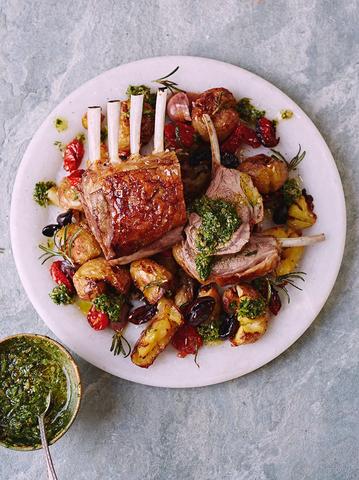
When serving rack of lamb, there are many delicious side dishes that pair well with its rich flavor. One popular choice is crispy roast potatoes, which provide a nice contrast in texture to the tender lamb. Another option is a roast asparagus salad, which adds a fresh and vibrant element to the meal. For a heartier side dish, roasted twice baked potatoes are a great choice. And if you’re looking for something light and refreshing, a simple wedge salad can be the perfect accompaniment to the lamb.
In terms of vegetable options, roasted asparagus with cranberries and feta is a flavorful choice that complements the lamb well. Shaved asparagus with pesto is another unique option that adds a burst of freshness to the plate. If you prefer green beans, try roasting them with mushrooms for a savory combination.
And of course, no rack of lamb meal would be complete without crispy roast potatoes. Whether seasoned simply with salt and pepper or dressed up with herbs and spices, roast potatoes are always a crowd-pleaser.
By choosing from these options or mixing and matching your favorites, you can create a well-rounded and satisfying meal that perfectly complements the flavors of the roasted rack of lamb.
In conclusion, this rack of lamb recipe offers a delicious and impressive meal option. With its simple preparation and flavorful marinade, it is sure to impress guests or elevate any dinner at home. The tender and juicy meat combined with aromatic herbs and spices creates a mouthwatering experience that will leave everyone wanting more.
Learn More About Grilling
If you want to learn more about grilling, check out these other helpful resources!

